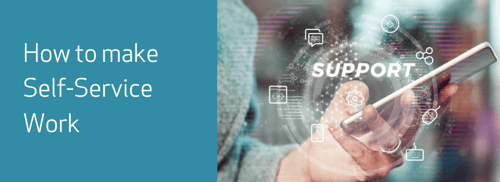In the context of integration, another much talked about feature over the past few years has been the “self-service portal”.
The idea of letting end users – or customers – help themselves stems from the early days of SaaS platforms and next generation service providers (bandwidth on demand, anyone?), but it is only now – with the whole WFH initiative being forced onto companies – that it is really becoming a critical element of the service desk operation. And why not? Company staff have become more than familiar with home shopping, including dealing with customer service, problems, returns and related issues, all on their laptop or smartphone, so why not apply that self-service/self-help scenario to the workplace? Given the “new norm”, the self-service portal suddenly makes an incredible amount of sense, not simply for IT scenarios, but any company operation, meaning that they are very “ESM friendly”. Providing remote users with a simple and efficient solution for managing their support activity across all business operations makes a huge amount of sense and provides a standardised way of dealing with any problems or user requirements. For example, simply being able to get instant answers/remedies, raise support requests, request access permissions and related activities – itself justifies the deployment of a self-service portal. We all know the basic benefits of deploying such a portal – lower support costs, empowered users, more productive service desk teams… but the benefits extend beyond these obvious advantages. Providing access to data, applications, tools and support 24×7 – for homeworkers especially, the 9-5 working day rules go out of the proverbial window (which might now look out onto the garden!) – moves portals into the role of productivity maximiser. Self-service portals allow companies to centralise relevant, up-to-date information and guidance that employees can easily access at any time – so there are no excuses on the “I didn’t know that” front. They provide a trusted source of guidance and reduce the risk of well-meant, but often misleading ‘word-of-mouth’ advice from colleagues.
Key here is to build in as much automation as possible, in order to avoid the otherwise inevitable swamping of the support team. So, we are now seeing how the different elements of a contemporary service desk solution themselves interact to improve the end product. And that end product can extend beyond the confines of the virtual company walls. It works perfectly for external parties, such as MSPs (and their customers) and doubles as a great marketing tool when interacting with customers. Additionally, they make for great educational tools – training the user, improving their knowledge base and – vitally – make that information available 24×7.
Crucially therefore, designing a customer/self-service portal as a configurable platform, rather than as a fixed application, means that it can continue to expand into any relevant area and become the primary driver of a service desk. After all, the end user is the entire raison d’etre of service management in the first place, so why not let them effective drive it forward in the future?
Steve Broadhead is a technology journalist, technical researcher & author, guitarist and occasional comedy writer, who brings his unique perspective to the world of ITSM through 30+ years’ association with the IT industry.
Watch the webinar recording of The Integrated Service Desk – extending boundaries adds value




.png)
